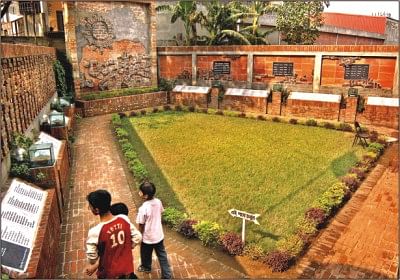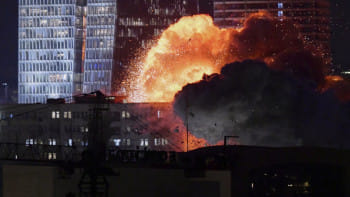<i>Genocide still haunts survivors </i>

Children visiting the Jalladkhana in Mirpur-10 look at the names of 400 killing fields across the country where the Pakistani army and their local collaborators in 1971 killed freedom fighters and dumped their bodies.Photo: Syed Zakir Hossain
It was on a Friday in the end of March in 1971 when Samiran Nesa last saw her neighbour Abdur Rahman being dragged away by Biharis from a road near the place now known as Jalladkhana in Mirpur.
Rahman appeared on the scene after the Azan for Juma prayers was announced and he was never seen again.
"I just saw two Biharis surrounding him on the road which now leads before the Desco office near Jalladkhana. I did not see where he was taken as it happened very quickly," said Samiran, who was standing on the road holding a pitcher that day.
Samiran, whose husband moved her elsewhere for shelter, next Friday received a message from another neighbour saying, "We could not bring him (her husband Abdul Hakim) back with us."
"This message is the last memory regarding my husband. I have not heard anything about him since then," added Samiran, who now resides at 10/B, 14/12 Section-10 in Mirpur.
It was drizzling outside with black clouds clustering over the sky of Jalladkhana as Samiran recollected the memories during one of her regular visits to Jalladkhana [place of execution] on Tuesday.
While she spoke her last words, Mohammad Fariduzzaman, son of martyr Akrob Ali, Abdul Gafur, and younger brother of martyr Abdur Rahman arrived one after another. They all visit the place regularly commemorating their loved ones lost in the Liberation War.
"What can I do to ease my pain? Whenever I fail to withstand the pain, I pay a visit to this place. It calms my pain to some extent," Samiran said while the others nodded their head in a silent sign of approval.
Like Abdur Rahman and Abdul Hakim, several thousands of Bangalees went missing from the areas adjacent to Jalladkhana, a memorial for the martyrs of the Liberation War where invading Pakistani army and their local collaborators killed thousands of Bangalees in one of the worst genocides of the 20th century.
Bodies were thrown into the underground water tank of Jalladkhana, which had been a pump house since 1965 and was used as killing and dumping bodies to destroy all evidence. But almost after three decades an excavation led to the exhumation of the mass grave, recovering 70 human skulls and 5,392 pieces of bone from the place.
According to Nasir, who looks after the memorial, there are families around Jalladkhana who saw their near and dear ones being dragged away towards that 'executing' place never to return again.
After eight years of the exhumation, the Liberation War Museum built a triangular memorial on the site of the torture chamber and the mass grave keeping the structure of the pump house unchanged.
The museum has already listed names of 65 martyrs whose family members said they (martyrs) were taken to Jalladkhana before their eyes.
Locals and freedom fighters have identified over 450 killing grounds across the country, each containing the history and evidence of mass killing during 1971.
"Our prime duty would be to start with the process of trial of the war criminals. It would be difficult to detect all the killers and collaborators of our War of Independence by their individual identity. But there is more than enough evidence to bring the key players behind the mass killing into book," Akku Chowdhury, a trustee of the Liberation War Museum, told The Daily Star.
"The mass killing ground and the pieces of evidence available in our hands bear the testimony how Bangalees were killed in riots. The key players were responsible for inciting the riots and committing the genocide. Newspaper reports, especially those from the Daily Sangram, mouthpiece of Jamaat-e-Islami, are the best proof that some key players incited the riot and created the genocide," he added.
As trial of war criminals comes into fore in the country and gets momentum under the present government, family members and witnesses to the killings are getting prepared to see the justice at last.
And so is Sheikh Sharikul Islam Bablu, an eyewitness to the mass killing at Jalladkhana, who cheated death miraculously.
He is living evidence answering to the words "What Happened" engraved in five languages on the entrance to the memorial.
The words have been extrapolated from a publication of the International Coalition of Historic Site Museums to inspire visitors to be curious and to learn from the site.
"Don't you know all the Bangalees who used to live here have been killed? Don't you know all the Bangalees who fail to escape from this area are killed?" said Bablu quoting Bihari leader Naser, who helped him escape from Jalladkhana on July 28, 1971.
Bablu, who deserted his home in the area on March 23, 1971, went to the intersection near Jalladkhana that day to take news of what happened to the Bangalees who could not escape.
A Bihari friend of Bablu saved his life while he was lying on the floor inside Jalladkhana with his head on the manhole of the pump house. Three Biharis were holding him and already held the sword on his neck once.
"The floor was littered with sandals of different sizes including those of kids and women and clothes including scarf and sarees. It was also covered with thick blood," Bablu recollected the scene when he was lying under the sword for being executed.

 For all latest news, follow The Daily Star's Google News channel.
For all latest news, follow The Daily Star's Google News channel. 



Comments